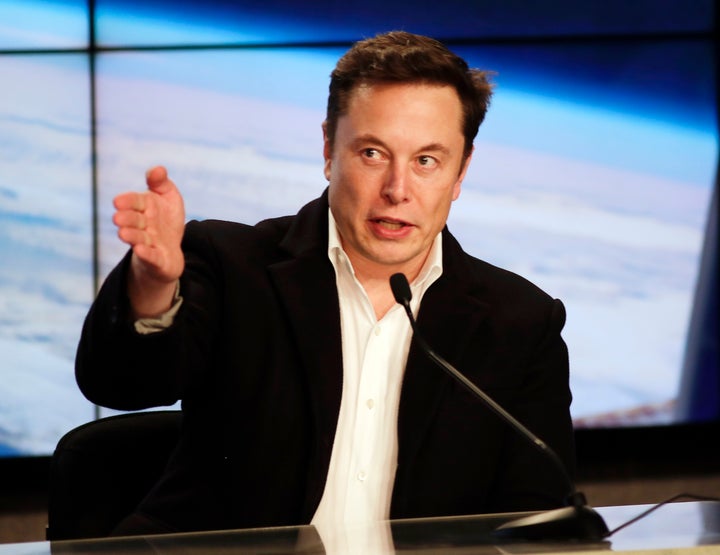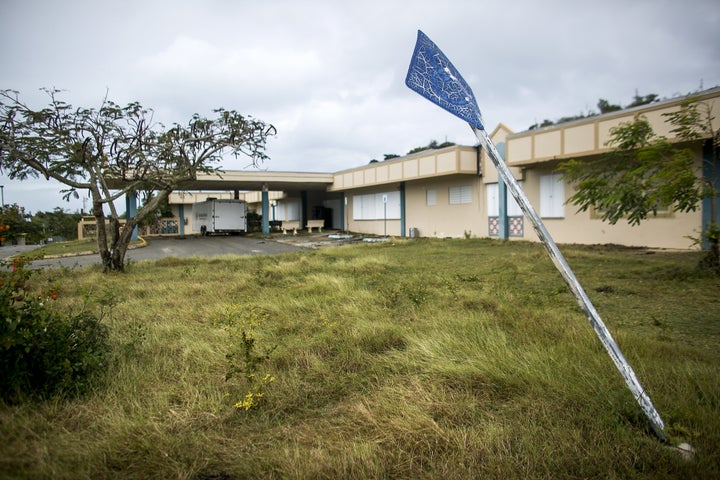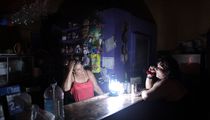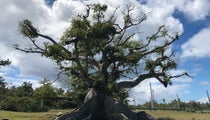VIEQUES, Puerto Rico ― It looks like something out a brochure advertising what renewable energy could offer a remote, storm-ravaged island.
Electrical lines still hang perilously from poles across the street, but inside the mint-green, one-story Ciudad Dorada senior center, fans blow cool air and refrigerators stocked with insulin and other medicines run cold even as the noon sun broils in a cloudless Caribbean sky. On its roof are a set of Tesla photovoltaic solar panels, attached via cable to a pair of Tesla batteries hitched to the wall beneath.
And yet, a diesel generator growls on full blast behind the center.
Workers from Tesla, billionaire Elon Musk’s electric car and solar energy giant, arrived on Vieques just weeks after hurricanes Irma and María crippled the aging electrical grid and severed the transmission cable that connected this island to the Puerto Rico mainland seven miles west. The company selected the senior center as one of 11 sites on the darkened island that it would equip with power-producing panels and batteries.
Constructing the system was simple. But when workers attached the panels and batteries to the old electrical wiring in the former schoolhouse, the batteries blew out.
“It doesn’t work,” a nurse at the senior center said in Spanish during a HuffPost visit in late February. “It never has.”
The circuitry issue proved ominous. Officials promised that Tesla’s effort heralded a brighter future on Vieques, one that would free the island from dependence on fossil fuels and make it a model for the rest of Puerto Rico. But apparent supply shortages, regulatory hurdles and a lack of long-term planning dashed those hopes. Today the island still depends on dirty power from the mainland, and some solar panels and batteries sit useless and broken with another hurricane season less than a month away.
“We’re back to square one,” said Edgar Oscar Ruiz, 34, a local activist pushing for renewable energy on Vieques. “Tesla came in with great intentions, but that’s not enough.”
Vieques’ experience shows what renewable energy experts say are the risks of relying on corporate goodwill to deliver transformative change and highlights the potential hurdles that Puerto Rico now faces as it seeks to convert the territory’s entire electricity system to renewable energy and sell off parts of its public utility.
“There’s a cautionary tale here,” said Andrea Luecke, president of the Solar Foundation, an industry nonprofit.
A Sunny Proposal
Tesla staffers arrived in Puerto Rico a week after Hurricane María made landfall on Sept. 20, 2017, and before many relief workers. By November, the company sent an unsolicited proposal to the Puerto Rican government. The pitch included building solar power microgrids ― which would produce and distribute power autonomous of the territory’s main electrical grid ― on Vieques and Culebra, its smaller, more touristy neighbor. The content of the proposal, though never made public, is confirmed in a study released by the Puerto Rican government. Puerto Rican Gov. Ricardo Rosselló touted the effort in December 2017.
“These projects are part of the measures we are taking to build a better Puerto Rico after the passage of Hurricane María and ensure a reliable service for the benefit of the citizens who reside here,” Rosselló told Radio Isla 1320 back then.
Around the same time, Tesla contacted the municipal government on Vieques to begin talks about buying public land on which to build a microgrid, according to Carlos Jirau, a development consultant working for the mayor.
“Tesla was asking for the possibility to acquire land from the municipality to develop a microgrid,” Jirau said. He said he requested a formal proposal but never heard back.
It’s easy to understand the opportunity Tesla saw. In 2016, the company had converted the entire electrical supply of Ta’u, a 600-resident island in American Samoa, to solar power and batteries. A year later, Tesla built a massive solar and battery farm on the Hawaiian island of Kauai.
Vieques represented not only another test case for its technology but a chance to do some good. The island ― dubbed “the colony of the colony” by some locals because of its history of human and environmental exploitation ― was languishing in what would become the second-longest blackout in world history.

Tesla worked quickly. It installed equipment at the Susana Centeno Hospital, the island’s lone medical center. It deployed units to Ciudad Dorada, the Boys and Girls Club of Vieques, an elderly daycare center, two water supply plants, a sewage treatment facility and three private homes occupied by elderly, single women.
“We’re just trying to be as helpful as we can in Puerto Rico,” a Tesla spokesman told HuffPost. “We had employees on the ground working to restore power as soon as the hurricane cleared, and we still have full-time employees there to this day. We’re committed to our efforts to expand clean energy there, including the large number of current and planned solar and storage installations across the island.”
For the most part, those targeted efforts to restore power after the storm succeeded. The company convinced many on the island of solar energy’s potential and several other sites are now also installing panels, according to Mark Martin, a coordinator with the nonprofit Vieques Love who worked with Tesla.
“Vieques was abandoned,” Martin said, so the speed with which Tesla got electricity flowing again left an impression. “It was a culture change,” he said. “On the island, you can see a turn in the thinking.”
But larger permanent changes to infrastructure were limited.
At one water treatment facility, the battery sat dormant and, during HuffPost’s visit to the site in late February, the field of solar panels was overgrown with weeds and brush. Several panels bore the shattered imprints of horse hooves, a predictable problem on an island with one wild horse for every two humans. The hospital ― damaged and mold-infested from the storm ― was permanently shuttered. After they helped to power a makeshift medical center, Tesla moved those solar panels, along with other equipment, to some of the 11,000 other sites it started work on across Puerto Rico.
Tesla didn’t boast about its Vieques projects specifically, and it wasn’t the only company to send equipment to the island; San Francisco-based Sunrun also deployed units after the storm. But Tesla’s efforts earned the most praise in media outlets including Fortune and Inc., in no small part due to Musk’s celebrity and his high-profile, if at times bizarre and calamitous, disaster relief efforts in other places. One popular clean-tech blog cited Vieques when it bellowed, “Musk’s Philanthropy Deserves Headlines.”
If Tesla had planned to lay the groundwork for an island-wide microgrid, existing regulations created an obstacle. On the territorial level, the state-owned Puerto Rico Electric Power Authority enjoyed a monopoly on power generation and distribution. Years of neglect and billions in debt left the power grid that PREPA oversaw fragile and unprepared to integrate new technologies. On the national level, the Federal Emergency Management Agency largely limits its funding aid for post-hurricane repairs to projects that restored existing infrastructure ― which made novel improvements, such as solar power microgrids, difficult to finance with public money.
The federal funding has also been fodder for a fight in Washington as President Donald Trump has raged against Puerto Rico, accusing its officials of mishandling relief money, and Democrats argue that a White House blinded by racism has left millions of American citizens to suffer.
Regulatory changes in Puerto Rico over the past year, however, promise to make it simpler to build renewable energy in the future. Last May, territorial regulators finalized rules easing the way for microgrids, though PREPA’s bankruptcy still complicates the process. In December, Rosselló signed a bill legalizing locally owned energy cooperatives. In March, the Puerto Rican legislature approved a bill mandating that 100% of the island’s electricity will be generated from renewable sources by 2050.
“This policy provides a pathway, a very robust pathway, for solar and batteries,” Rosselló told HuffPost in an interview last month, noting that the island had issued a request for proposals of new projects. “Companies like Tesla, Sunrun and others will be able to bid for that.”
The Puerto Rican government wants Vieques to be the test case for microgrids, Omar Marrero, director of the territory’s Public-Private Partnership Authority, told Quartz in an interview published in May.
“Whatever the generation [source], we all agree on microgrids,” he said.
‘A Solar Graveyard’
But agreeing on microgrids is just a first step. Puerto Rico produced just 2% of its power from renewables before the hurricanes, despite an existing law that required 12%, InsideClimate News reported. The new legislation’s ambitious benchmarks ― 20% by 2022 and 40% by 2025 ― seem at odds with PREPA’s plans to build out natural gas import terminals, pipelines and power generators.
It’s not enough either to build the solar panel and battery farms. They have to be maintained. The busted solar panels at the facility on Vieques’ northern shore is a textbook case of what Jenean Smith, an executive at the California-based nonprofit solar installer Grid Alternatives, calls a “solar graveyard.”
The term refers to the phenomenon of companies or nonprofits bringing photovoltaic panels and batteries to underdeveloped economies and then leaving them to fall into disrepair as the locals administering the systems struggle to maintain them.

“We see it with off-grid systems all around the world, where well-intentioned organizations will install systems, get a lot of PR, get funding upfront, then they leave,” Smith said by phone. “And there’s a disconnect between the PR and the reality on the ground.”
The best way to avoid this, Smith said, is for companies or foundations that fund these projects to put aside extra money to hire and train maintenance staff.
“We proactively visit all of the systems we’ve installed and we make sure we check in with people,” she said. “You have to build in a budget a project management system ― not just for when it’s installed but for the next five, 10, 15 years.”
The new rules allowing energy co-ops offer some hope. The model retains the public ownership that opponents of PREPA’s privatization want but empowers the community benefiting from the project to help maintain the operation, according to Nelson Colón, chief executive of the Puerto Rico Community Foundation, a nonprofit that is building solar co-ops in the territory.
“There is a challenge when a private commercial entity comes and deploys solar panels and batteries ― then the community is not engaged, the community is not part of it,” Colón said by phone. “In our model, the community is a very active participant.”
The foundation is raising money for a fund to build a “Green Corridor” of co-op projects from Culebra through Vieques, all the way to the western tip of the main island.
That local-ownership model offers fewer openings for private companies to shake down ratepayers. It also sets a standard for long-term contracts that factor in system maintenance.
“There’s a tendency of companies wanting to rush in and fix things and be as reactive as possible,” Luecke said. “That tendency is wrong.”
For Tesla, reacting to public need in select places has paid dividends, at least in terms of good press. The projects in Ta’u and Kauai generated adulatory coverage. Last July, the firm said it would do the same for the entire island nation of Samoa. In January, Tesla set its sights on Greece’s backyard of islands.

But historically, the company’s ambitions have often outpaced its capacities. Over the past year, Tesla repeatedly said in calls with investors that it was prioritizing production of the Model 3 car over batteries for solar units. Wait times for parts of a solar power system ranged from six months to a year, USA Today reported last summer. Customers who bought batteries and solar roofing faced delays twice as long as what salespeople originally promised, according to a June 2018 report in Business Insider. One purported buyer last July claimed on Twitter that the company informed him that all shipments and installs were “halted indefinitely.”
“We would have done more in stationary storage last year except we were cell-starved for vehicle production,” Musk said in an earnings call in January. “So we had to convert a bunch of stationary storage lines, battery lines, to vehicle battery lines.”
For the handful of Vieques residents who tried to buy Tesla batteries themselves, this became an obstacle, said Ruiz, the local activist.
“We were told there’s a nine-month waiting list,” he said. “It just never materialized.”
A Dark Past
While Vieques has become a vacation hub in recent years, drawing tourists to quiet black-sand beaches and the world’s brightest bioluminescent bay, its newfound Instagram glamour belies a disturbing past and a lasting, toxic legacy.
Europeans settled Vieques in the 19th century, circumventing the peasant farming economy that thrived on the Puerto Rican mainland to establish an entirely slave-based sugar plantation model. When Spain abolished slavery in 1873 ― a decade after the United States ― many former slaves and newcomers from other Caribbean islands became agregados, essentially feudal sharecroppers who continued the harsh work of planting and harvesting sugarcane. That system lasted from the United States’ invasion in 1898 until the 1940s, when the U.S. Navy decided to build a base to defend its Caribbean colony from German U-boats.
Wielding the power of eminent domain, the military compensated some landowners but refused to pay poor farmers, instead bulldozing their homes and forcing them into a small area making up barely a third of the island. After World War II, the Navy turned half of Vieques into a target range for new weapons, including uranium-based munitions. Around 2000, the Navy accidentally killed a local resident in a bombing run, triggering a protest movement that many here call “the struggle,” which culminated in the military deciding to close the base. That choked off the island’s main economic engine.
Today, much of Vieques is a Superfund site. The cancer rate is 30% higher than in the rest of Puerto Rico, and hypertension is four times as common, according to research cited by Al Jazeera.
The storms a year and a half ago inflamed the existing inequity on this island of roughly 9,000.
Even before officials condemned the Susana Centeno Hospital, the storms wrecked its Diagnostic and Treatment Center, which provided dialysis to 10 people on the island. As a result, those patients, many of them fragile, had to make an arduous 25-mile trip by land and air to the Fresenius Kidney Care Center in Humacao on the Puerto Rican mainland.
Vieques feels locked in what NBC News called the “never-ending task” of rebuilding. In March 2018, municipal documents submitted to Puerto Rico’s Housing Department as part of a federal block grant program showed that the island needed at least $65 million to repair homes and public infrastructure. A year later, Vieques remains tattered, with many damaged homes covered in blue tarps easily visible from its main roads.
It took 18 months to reconnect Vieques to the Puerto Rican power grid. At the western tip of the island, the rebuilt transmission cable from the mainland is protected only by a mangled nest of chainlink fence surrounding a hastily poured block of concrete.
So it’s no surprise that long-time residents like Kathy Gannett are cynical about the future of projects like a microgrid.
“Was it good that Tesla came in and served our emergency needs? Of course. But it was terrible they left their equipment to decay when we’re so in need of resources,” she said. “But we are overwhelmed by just fighting for basic things like our ferry service and getting a decent hospital, so those issues take all of our time.”
This story has been updated to include a new statement from Tesla.





Recent Comments